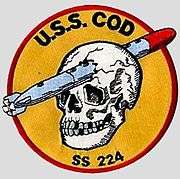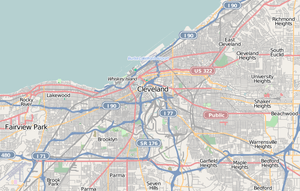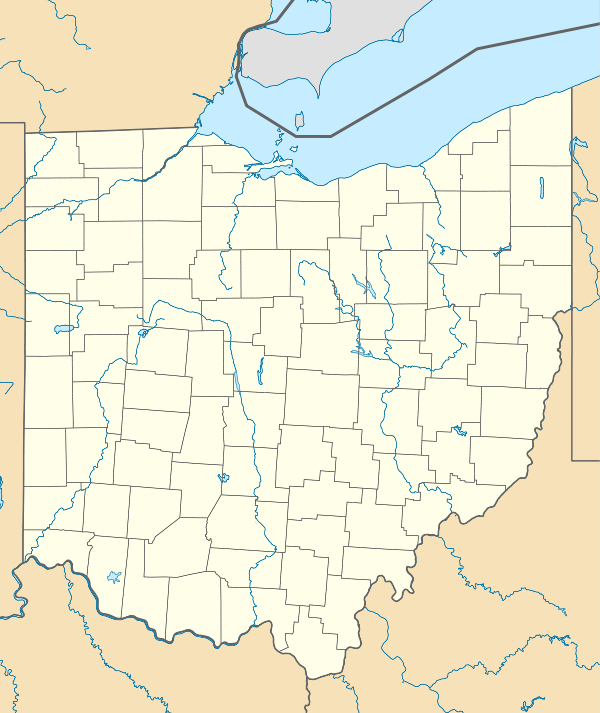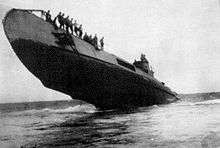USS Cod
 | |
| History | |
|---|---|
| Name: | USS Cod |
| Namesake: | Cod |
| Ordered: | 1941 |
| Builder: | Electric Boat Company, Groton, Connecticut http://www.navsource.org/archives/08/08224.htm |
| Laid down: | 21 July 1942[1][2] |
| Launched: | 21 March 1943[1] |
| Sponsored by: | Mrs. G.M. Mahoney |
| Acquired: | 21 June 1943 |
| Commissioned: | 21 June 1943[1] |
| Decommissioned: | 21 June 1954 |
| In service: | 1943 |
| Out of service: | 1971 |
| Struck: | 15 December 1971[1] |
| Fate: | Museum ship |
| Status: | Museum ship at Cleveland, Ohio since 01 May 1976 [3] |
| Badge: |
 |
| General characteristics | |
| Class and type: | Gato-class diesel-electric submarine[3] |
| Displacement: | |
| Length: | 312 ft 0 in (95.10 m)[3] |
| Beam: | 27 ft 3 in (8.31 m)[3] |
| Draft: | 17 ft (5.2 m) maximum[3] |
| Propulsion: |
|
| Speed: | |
| Range: | 11,000 nautical miles (20,000 km) surfaced at 10 kn (19 km/h)[7] |
| Endurance: |
|
| Test depth: | 300 ft (90 m)[7] |
| Complement: | 6 officers, 54 enlisted[7] |
| Armament: |
|
|
USS Cod (submarine) | |
|
USS Cod moored at its permanent location in Cleveland's North Coast Harbor. | |
   | |
| Location | Cleveland, Ohio |
| Coordinates | 41°30′36.3″N 81°41′29.7″W / 41.510083°N 81.691583°WCoordinates: 41°30′36.3″N 81°41′29.7″W / 41.510083°N 81.691583°W |
| Area | less than one acre |
| Built | 1942 |
| Built by | Electric Boat Company, Groton, Connecticut |
| Architectural style | Other, Submarine |
| NRHP Reference # | 86000088[8] |
| Added to NRHP | 14 January 1986 |
USS Cod (SS/AGSS/IXSS-224) is a Gato-class submarine, the only vessel of the United States Navy to be named for the cod, named after the world's most important food fish of the North Atlantic and North Pacific.
Her keel was laid down by the Electric Boat Company of Groton, Connecticut on 21 July 1942. The submarine's five diesel engines were built by General Motors' Cleveland Diesel plant located on the west side of Cleveland. She was launched on 21 March 1943 (sponsored by Mrs. G.M. Mahoney), and commissioned on 21 June 1943 with Commander James C. Dempsey in command. Dempsey had already won fame by sinking the first Japanese destroyer lost in the war while in command of a tiny, World War I-era submarine.
She is now permanently moored as a museum ship in Cleveland, Ohio, and is open to visitors.
World War II
First and Second Patrols
Cod arrived in Brisbane, Australia, on 2 October 1943 to prepare for her first war patrol. She sailed from there 20 days later. Penetrating the South China Sea, she contacted few targets, and launched an attack only once, on 29 November, with unobserved results. Returning to Fremantle, Western Australia, to refit from 16 December 1943 to 11 January 1944, Cod put to sea for her second war patrol in the South China Sea, off Java, and off Halmahera. On 16 February, she surfaced to sink a sampan by gunfire, and on 23 February, torpedoed a Japanese merchantman. She sent another to the bottom on 27 February and two days later attacked a third, only to be forced deep by a concentrated depth charging delivered by a Japanese escort ship.
Third and Fourth Patrols
Refitting at Fremantle again from 13 March – 6 April 1944, Cod sailed to the Sulu Sea and the South China Sea off Luzon for her third war patrol. On 10 May, she attacked a heavily escorted convoy of 32 ships and sank the destroyer Karukaya and a cargo ship before the escorts drove her down with depth charges. Returning to Fremantle to replenish on 1 June, she left again 3 July on her fourth war patrol, under the command of Commander James "Caddy" Adkins. She ranged from the coast of Luzon to Java. She sank a merchantman on 3 August, and a landing craft, LSV-129, on 14 August, and, once more successful, returned to Fremantle 25 August.
Fifth Patrol
Cod put to sea on her fifth war patrol 18 September 1944, bound for Philippine waters. She made her first contact, a cargo ship, on 5 October, and sank it. Two days later, she inflicted heavy damage on a tanker. Contacting a large convoy on 25 October, Cod launched several attacks without success. With all her torpedoes expended, she continued to shadow the convoy for another day to report its position. In November she took up a lifeguard station off Luzon, ready to rescue carrier pilots carrying out the series of air strikes on Japanese bases which paved the way for the invasion of Leyte later that month.
Cod returned to Pearl Harbor on 20 November 1944, and sailed on to a stateside overhaul at Mare Island Naval Shipyard, returning to Pearl Harbor on 7 March 1945.
Sixth and Seventh Patrols
On 24 March she sailed from Pearl Harbor for the East China Sea on her sixth war patrol. Assigned primarily to lifeguard duty, she used her deck gun to sink a tug and its tow on 17 April, rescuing three survivors, and on 24 April launched an attack on a convoy which resulted in the most severe depth charging of her career. The next day, she sent the minesweeper W-41 to the bottom. On 26 April Cod was threatened by a fire in the aft torpedo room, but the ship's crew brought the fire under control and manually launched a torpedo already in its tube before the fire could detonate it. QM2c L.E. Foley and S1c A.G. Johnson were washed overboard while freeing the torpedo room hatch. Foley was recovered the next morning, but Johnson was drowned during the night, the Cod's only fatality during the war.[9]

After refitting at Guam between 29 May and 26 June 1945, Cod put out for the Gulf of Siam and the coast of Indo-China on her seventh war patrol under the command of Lieutenant commander Edwin M. Westbrook, Jr. On 9 and 10 July she went to the rescue of a grounded Dutch submarine, O 19, taking its crew on board and destroying the Dutch boat when it could not be gotten off the reef. This was the only international submarine-to-submarine rescue in history. After returning the Dutch sailors to Subic Bay, between 21 July and 1 August Cod made 20 gunfire attacks on the junks, motor sampans, and barges which were all that remained to supply the Japanese at Singapore. After inspecting each contact to rescue friendly natives, Cod sank it by gunfire, sending to the bottom a total of 23. On 1 August, an enemy plane strafed Cod, forcing her to dive, leaving one of her boarding parties behind. The men were rescued two days later by Blenny (SS-324).
When Cod returned to Fremantle 13 August 1945, the crew of O-19 was waiting to throw a party for their rescuers. During that celebration, the two crews learned of the Japanese surrender. To symbolize that moment, another symbol was added to Cod's battle flag: the name O-19 under a martini glass.[10]
Cod sailed for home on 31 August. Arriving in New London, on 3 November after a visit to Miami, Florida, Cod sailed to Philadelphia for overhaul, returning to New London where she was decommissioned and placed in reserve 22 June 1946.
Post-War Service
Cod was recommissioned in 1951, under the command of Captain Francis E. Rich, to participate in NATO anti-submarine training exercises. During the Cold War, Cod traveled to St. John's, Newfoundland, as well as Cuba and South America.
Cod was decommissioned in 1954 and placed in reserve. In 1959 she was towed through the St. Lawrence Seaway to Cleveland, Ohio, and used as a training vessel. Cod was reclassified first as an Auxiliary Submarine (AGSS-224) on 1 December 1962, and later as a Miscellaneous Unclassified Submarine (IXSS-224) on 30 June 1971. In 1971, Cod was stricken from the Naval Vessel Register.
Awards
Cod is credited with sinking more than 12 enemy vessels totalling more than 37,000 tons, and damaging another 36,000 tons of enemy shipping. All seven of her war patrols were considered successful and Cod was awarded seven battle stars. Cod's battleflag and conning tower both carry a cocktail glass above the name "O-19" to commemorate the rescue and the party. Patrols 1, 2, and 3 were under the command of Commander James C. Dempsey, USN; patrols 4, 5, and 6 were under the command of Commander James "Caddy" Adkins, USN; and patrol 7 was under the command of Lieutenant commander Edwin M. Westbrook, Jr., USN. When recommissioned in 1951, Cod was under the command of Captain Francis E. Rich, USN, and was placed out of commission by Captain Joseph Adelman, USN.
Museum Ship and National Historic Landmark
A group of Cleveland residents formed the Cleveland Coordinating Committee to Save Cod, Inc., with the goal of preserving the ship as a memorial. In 1976 January, the U.S. Navy gave guardianship of the submarine to the group. Cod opened for public tours as a floating memorial in 1976 May. In 1986, the U.S. Department of the Interior designated Cod a National Historic Landmark. The memorial is open daily between 1 May and 30 September of each year from 10:00 a.m. to 5:00 p.m.
Today, Cod is one of the finest restored submarines on display and is the only U.S. submarine that has not had stairways and doors cut into her pressure hull for public access. Visitors to this proud ship use the same vertical ladders and hatches that were used by her crew. Cleveland can claim partial credit as Cod's birthplace, since the submarine's five massive diesel engines were built at the General Motors Cleveland Diesel plant on Cleveland's west side. In addition, she also has unique attractions such as the 5 inch deck gun that still can be rotated by visitors and mock fired by Cods volunteer crew and rare access to the conning tower in which visitors can peer through a working 1940's periscope. The Cod 's Mark IV Torpedo Data Computer is fully restored, as well as her radio shack, and other various things on the submarine.
The Cod memorial acquired two General Motors Model 248 engines that had originally been used aboard another World War II submarine, Stingray (SS-186). The two V-16, 1,600 HP diesel engines were originally built in Cleveland, Ohio the last in 1943, out of the General Motors Cleveland Diesel Plant on the west side. The engines were used for parts for the restoration of Cod's engines. Three out of the four main engines on the Cod are in running and working order, and are fired up on special events through out the year. In 2013 the Cleveland office of PetroLiance helped the Cod get 500 gallons of fresh oil to operate her newly restored engines." We are proud to help Cod get her engines running again," said PetroLiance regional VP Jim McClellan. It amounts to about a $10,000 donation, said Paul Farace, President of the Cod memorial.
Film Production
Cod was used for exterior and interior scenes in the 2016 Smithsonian Channel war documentary Hell Below to depict the USS Tang , U-99 and U-100.
Filming took place aboard the Cod in 2015. The series premiered Sunday July 17, 2016.
References
- 1 2 3 4 Friedman, Norman (1995). U.S. Submarines Through 1945: An Illustrated Design History. Annapolis, Maryland: United States Naval Institute. pp. 285–304. ISBN 1-55750-263-3.
- ↑ Friedman, Norman (1995). U.S. Submarines Through 1945: An Illustrated Design History. Annapolis, Maryland: United States Naval Institute. pp. 285–304. ISBN 1-55750-263-3.
- 1 2 3 4 5 6 7 Bauer, K. Jack; Roberts, Stephen S. (1991). Register of Ships of the U.S. Navy, 1775–1990: Major Combatants. Westport, Connecticut: Greenwood Press. pp. 271–273. ISBN 0-313-26202-0.
- 1 2 3 4 5 Bauer, K. Jack; Roberts, Stephen S. (1991). Register of Ships of the U.S. Navy, 1775–1990: Major Combatants. Westport, Connecticut: Greenwood Press. pp. 275–280. ISBN 978-0-313-26202-9.
- ↑ U.S. Submarines Through 1945 p. 261
- ↑ U.S. Submarines Through 1945 pp. 305–311
- 1 2 3 4 5 6 U.S. Submarines Through 1945 pp. 305–311
- ↑ National Park Service (2010-07-09). "National Register Information System". National Register of Historic Places. National Park Service.
- ↑ McDaniel, J.T., Ed. (2005) U.S.S. Cod: American Submarine War Patrol Reports, Riverdale, Georgia: Riverdale Books, pp. 241–242. ISBN 1-932606-04-1
- ↑ http://www.criticalpast.com/video/65675076083_USS-Cod_Dutch-submarine_holding-rubber-raft_airplane-in-flight Video of USS Cod sinking O 19
- This article incorporates text from the public domain Dictionary of American Naval Fighting Ships. The entry can be found here.
- Butowsky, Harry A. (May 1985). "National Register of Historic Places Inventory Nomination Form / USS Cod (SS-224)" (pdf). Retrieved 2012-08-27.
- Butowsky, Harry A. (May 1985). "Accompanying Photos" (pdf). Retrieved 2012-08-27.
External links
| Wikimedia Commons has media related to USS Cod. |
- USS Cod website
- Photo gallery of USS Cod at NavSource Naval History
- hazegray.org: USS Cod
- List of the men who served on the Cod
- USS Cod at Historic Naval Ships Association
- Video of USS Cod sinking O 19
.jpg)